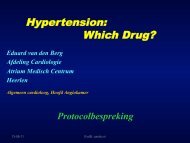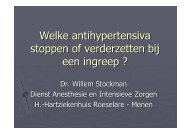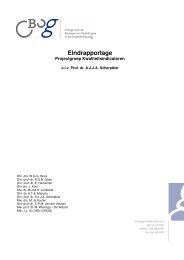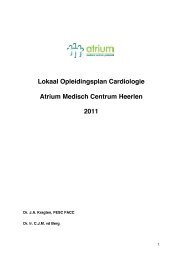Guidelines on the Management of Stable Angina Pectoris ... - Cardio
Guidelines on the Management of Stable Angina Pectoris ... - Cardio
Guidelines on the Management of Stable Angina Pectoris ... - Cardio
Create successful ePaper yourself
Turn your PDF publications into a flip-book with our unique Google optimized e-Paper software.
ESC <str<strong>on</strong>g>Guidelines</str<strong>on</strong>g> 7important when taking <strong>the</strong> history to identify those patientswith unstable angina, which may be associated with plaquerupture, who are at significantly higher risk <strong>of</strong> an acutecor<strong>on</strong>ary event in <strong>the</strong> short-term. Unstable angina maypresent in <strong>on</strong>e <strong>of</strong> <strong>the</strong> three ways: (i) as rest angina, i.e.pain <strong>of</strong> characteristic nature and locati<strong>on</strong>, but occurring atrest and for prol<strong>on</strong>ged periods, up to 20 min; (ii) rapidlyincreasing or crescendo angina, i.e. previously stableangina, which progressively increases in severity and intensityand at lower threshold over a short period, 4 weeks orless; or (iii) new <strong>on</strong>set angina, i.e. recent <strong>on</strong>set <strong>of</strong> severeangina, such that <strong>the</strong> patient experiences marked limitati<strong>on</strong><strong>of</strong> ordinary activity within 2 m<strong>on</strong>ths <strong>of</strong> initial presentati<strong>on</strong>.The investigati<strong>on</strong> and management <strong>of</strong> suspected unstableangina is dealt with in guidelines for <strong>the</strong> management <strong>of</strong> ACS.For patients with stable angina, it is also useful to classify<strong>the</strong> severity <strong>of</strong> symptoms using a grading system such as that<strong>of</strong> <strong>the</strong> Canadian <strong>Cardio</strong>vascular Society Classificati<strong>on</strong>(Table 3). This is useful in determining <strong>the</strong> functi<strong>on</strong>al impairment<strong>of</strong> <strong>the</strong> patient and quantifying resp<strong>on</strong>se to <strong>the</strong>rapy.The Canadian <strong>Cardio</strong>vascular Society Classificati<strong>on</strong> 74 iswidely used as a grading system for angina to quantify <strong>the</strong>threshold at which symptoms occur in relati<strong>on</strong> to physicalactivities. Alternative classificati<strong>on</strong> systems such as DukeSpecific Activity Index 75 and Seattle angina questi<strong>on</strong>naire 76may also be used in determining <strong>the</strong> functi<strong>on</strong>al impairment<strong>of</strong> <strong>the</strong> patient and quantifying resp<strong>on</strong>se to <strong>the</strong>rapy and may<strong>of</strong>fer superior prognostic capability. 77Physical examinati<strong>on</strong> <strong>of</strong> a patient with (suspected) anginapectoris is important to assess <strong>the</strong> presence <strong>of</strong> hypertensi<strong>on</strong>,valvular heart disease, or hypertrophic obstructive cardiomyopathy.Physical examinati<strong>on</strong> should include assessment<strong>of</strong> body-mass index (BMI) and waist circumference to assistevaluati<strong>on</strong> <strong>of</strong> <strong>the</strong> metabolic syndrome, 78,79 evidence <strong>of</strong>n<strong>on</strong>-cor<strong>on</strong>ary vascular disease which may be asymptomatic,and o<strong>the</strong>r signs <strong>of</strong> comorbid c<strong>on</strong>diti<strong>on</strong>s. However, <strong>the</strong>re areno specific signs in angina pectoris. During or immediatelyafter an episode <strong>of</strong> myocardial ischaemia, a third or fourthheart sound may be heard and mitral insufficiency mayalso be apparent during ischaemia. Such signs are,however, elusive and n<strong>on</strong>-specific.Table 3 Classificati<strong>on</strong> <strong>of</strong> angina severity according to <strong>the</strong>Canadian <strong>Cardio</strong>vascular SocietyClassClass IClass IIClass IIIClass IVLevel <strong>of</strong> symptoms‘Ordinary activity does not cause angina’<strong>Angina</strong> with strenuous or rapidor prol<strong>on</strong>ged exerti<strong>on</strong> <strong>on</strong>ly‘Slight limitati<strong>on</strong> <strong>of</strong> ordinary activity’<strong>Angina</strong> <strong>on</strong> walking or climbing stairs rapidly,walking uphill or exerti<strong>on</strong> after meals, incold wea<strong>the</strong>r, when under emoti<strong>on</strong>al stress,or <strong>on</strong>ly during <strong>the</strong> first few hours after awakening‘Marked limitati<strong>on</strong> <strong>of</strong> ordinary physical activity’<strong>Angina</strong> <strong>on</strong> walking <strong>on</strong>e or two blocks a <strong>on</strong> <strong>the</strong> levelor <strong>on</strong>e flight <strong>of</strong> stairs at a normal pace undernormal c<strong>on</strong>diti<strong>on</strong>s‘Inability to carry out any physical activitywithout discomfort’ or ‘angina at rest’a Equivalent to 100–200 m.Laboratory testsLaboratory investigati<strong>on</strong>s may be loosely grouped into thosethat provide informati<strong>on</strong> related to possible causes <strong>of</strong>ischaemia, those that may be used to establish cardiovascularrisk factors and associated c<strong>on</strong>diti<strong>on</strong>s, and those thatmay be used to determine prognosis. Some laboratory investigati<strong>on</strong>sare used for more than <strong>on</strong>e <strong>of</strong> <strong>the</strong>se purposes andmay be applied routinely in all patients, whereas o<strong>the</strong>rinvestigati<strong>on</strong>s should be reserved for use where clinicalhistory and/or examinati<strong>on</strong> indicates a particular need for<strong>the</strong>ir applicati<strong>on</strong>.Haemoglobin and, where <strong>the</strong>re is clinical suspici<strong>on</strong> <strong>of</strong> athyroid disorder, thyroid horm<strong>on</strong>es provide informati<strong>on</strong>related to possible causes <strong>of</strong> ischaemia. The full bloodcount incorporating total white cell count as well as haemoglobinmay also add prognostic informati<strong>on</strong>. 80 If <strong>the</strong>re isclinical suspici<strong>on</strong> <strong>of</strong> instability, biochemical markers <strong>of</strong> myocardialdamage such as trop<strong>on</strong>in or CKMB (creatine kinasemyocardial band), measured by mass assay, should beemployed to exclude myocardial injury. If <strong>the</strong>se markersare elevated, management should c<strong>on</strong>tinue as for an ACSra<strong>the</strong>r than stable angina. After initial assessment, <strong>the</strong>setests are not recommended as routine investigati<strong>on</strong>sduring each subsequent evaluati<strong>on</strong>.Fasting plasma glucose 60,61,63,64,81,82,83,84 and fasting lipidpr<strong>of</strong>ile including total cholesterol (TC), high density lipoprotein(HDL) cholesterol, and low density lipoprotein(LDL) cholesterol, 55–58 and triglycerides 54,85 should be evaluatedin all patients with suspected ischaemic disease,including stable angina, to establish <strong>the</strong> patient’s riskpr<strong>of</strong>ile and ascertain <strong>the</strong> need for treatment. Lipid pr<strong>of</strong>ileand glycaemic status should be re-assessed periodically todetermine efficacy <strong>of</strong> treatment and in n<strong>on</strong>-diabeticpatients to detect new development <strong>of</strong> diabetes. There isno evidence to support recommendati<strong>on</strong>s for how regularlyreassessment should take place. C<strong>on</strong>sensus suggests annualmeasurement. Patients with very high levels <strong>of</strong> lipids, inwhom <strong>the</strong> progress <strong>of</strong> any interventi<strong>on</strong> needs to be m<strong>on</strong>itored,should have measurements more frequently.Patients with diabetes should be managed accordingly.Serum creatinine is a simple but crude method to evaluaterenal functi<strong>on</strong>. Renal dysfuncti<strong>on</strong> may occur due to associatedcomorbidity 86–91 such as hypertensi<strong>on</strong>, diabetes orrenovascular disease and has a negative impact <strong>on</strong> prognosisin patients with CVD, 92,93 giving good grounds for measurementat initial evaluati<strong>on</strong> in all patients with suspectedangina. The Cockcr<strong>of</strong>t–Gault formula 94 may be used toestimate creatinine clearance based <strong>on</strong> age, sex, weight,and serum creatinine. The comm<strong>on</strong>ly used formula is asfollows: ((140—age (years)) (actual weight (kg)))/(72 serum creatinine (mg/dL)), with multiplicati<strong>on</strong> by a factor<strong>of</strong> 0.85 if female.In additi<strong>on</strong> to <strong>the</strong> well-recognized associati<strong>on</strong> betweenadverse cardiovascular outcome and diabetes, elevati<strong>on</strong>s<strong>of</strong> fasting or post-glucose challenge glycaemia have alsobeen shown to predict adverse outcome in stable cor<strong>on</strong>arydisease independently <strong>of</strong> c<strong>on</strong>venti<strong>on</strong>al risk factors. 95–101Although HbAIc predicts outcome in <strong>the</strong> general populati<strong>on</strong>,<strong>the</strong>re is less data in those with CAD. 101,102 Obesity, and inparticular evidence <strong>of</strong> <strong>the</strong> metabolic syndrome, is predictive<strong>of</strong> adverse cardiovascular outcome in patients with establisheddisease as well as asymptomatic populati<strong>on</strong>s. 78,79,103The presence <strong>of</strong> <strong>the</strong> metabolic syndrome can be determined














